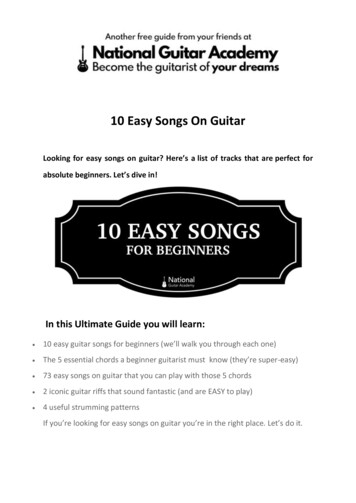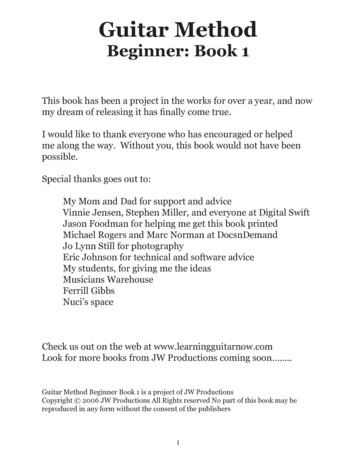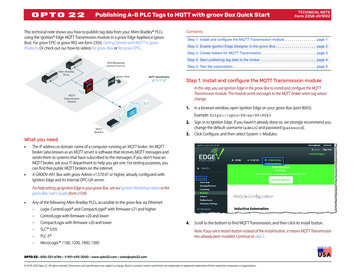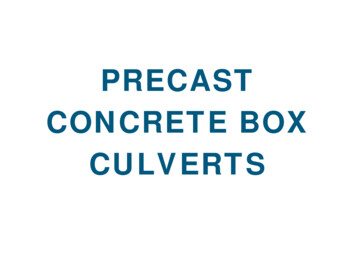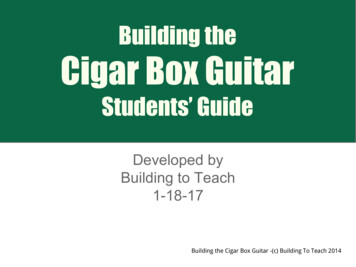
Transcription
Building theCigar Box GuitarStudents’ GuideDeveloped byBuilding to Teach1-18-17Building the Cigar Box Guitar -(c) Building To Teach 2014
IntroductionCigar Box Guitars are just like any otherguitar, only much easier to make! Followthe instructions in this guide to turn acigar box, a few pieces of wood andsome other supplies into a working,four string, fretless guitar,ready to play with a slide.This guide is divided intofour sections: The Box, The NeckThe Fret Scale, and Stringing and Tuning.There are tool and material lists for eachsection. This allows the class to bedivided into groups.
The Tools Needed (Overview) - Page 1Ruler or Tape MeasurePencilCombination SquareCompass (Carpenter's Scribers)Back Saw, or Hack SawCrosscut Saw, or BandsawDrillDrill Bits (for pilot holes and tuner holes: usually 1/16"and 5/16") Hole Saw (1"), Spade Bit, or Forstner Bit (For SoundHoles)
The Tools Needed (Overview) - Page 2 Chisel and Mallet (optional)Rasps and FilesAwl, or CenterpunchSmall Round File- 5/32" chainsaw fileSmall "C" clamps- 1 1/2" to 2 1/2" throat openingsLarger clamps- 4-6" throat openingsSmall (#1) Phillips ScrewdriverWoodburner (optional for marking fret spacing)Bridge Tuner (optional, but very nice for tuning theguitars)
The Necessary Materials Neck- 11/16" x 1 1/2" x 36- Straight grained hardwood is bestCigar Box- all wood is bestNut - Machine Screw #10 x 1 1/2"Bridge - Eye Bolt (or piece of threaded rod)1/4" x 4"Masking Tape - 3/4"- 1" wideFret Scale - 3" x 30" rectangle of pattern stock (such as 1/4" plywood, orstiff cardboard). Paper will also work.Four Guitar TunersType I Yellow Carpenters Glue - Such as Titebond I (with the red cap)Small Brads- 3/4"Guitar Strings: #1 - .034" Bronze Wound, #2 - .026" Bronze Wound, #3 - .017" Plain Steel, #4 - .013" Plain SteelGlass or Metal Guitar Slide
Guitar Parts/ Terms- eTail
Guitar Terms - Part 1Before you start building, it’s good to know exactly what it is you’rebuilding. Using complete sentences, please define each term as it relatesto a guitar. Once you’re done, get an instructor to check your answers. Neck- Head- Tail-Instructor’s Initials
Guitar Terms - Part 2 Bridge- Nut- Soundhole- Fret-Instructor’s Initials
Safety First!Make sure you use these while building: Safety Glasses Hearing Protection Dust MasksYou're brought into this world with two eyes, two ears, ten fingers and tentoes--make sure you keep them.When you are using a tool with a sharp edge, keep your hands on top of thetool, or behind the cutting edge of the blade.Most importantly, use common sense. It is your responsibility to know how touse your tools. If you don't know how to do something, ask your instructor.Read the Directions all the way through before starting.
Part 1 - The Box- IntroThe objective is to build a cigar box that will take thevibrations of the guitar strings and pump out the sound. Thisinvolves notching the box to fit the neck and cutting holes inthe box to let out the sound.The Objective is to make the top surface of the neck flush withthe top surface of the box. Boxes vary. So, keep the objectivesin mind.
The Box -The Tools Needed Ruler or Tape measure Pencil Combination Square Back Saw, Hack Saw Coping Saw Drill Hole Saw (1"), Spade Bit, or Forstner Bit (For SoundHoles) File and/ or rasp
The Box - The Necessary Materials Neck- 11/16" x 1 1/2" x 36- Straight grained hardwood isbest Cigar Box- an all wood box works best
Notching The Box- Page 1First, measure out the sides ofyour box that the neck willpass through.Length of each side inchesThen, find the center ofathose sides. To doso, take your answer aboveand divide it by 2.Length of side divided by 2 inches
Notching The Box- Page 2Next, measure the widthand thickness of the neck.Width of Neck InchesThickness of Neck InchesWidth Thickness -Then, find the center of thewidth, dividing it by 2.Width of Neck Divided by 2 Inches
Notching The Box- Page 3Mark a point on thesides of the box, atthe halfway pointyou calculated forthe box sides’length.½Widthof Neck½Widthof NeckThen, make two marks ineach direction from thatpoint, each equaling halfthe width of your neck.When you’re done, have an instructor check your work.Instructor’s Initials
Notching The Box- Page 4Use a combination square to drawvertical lines down from the ½width neck points. These need tobe the length of the thickness ofyour guitar’s neck, so make sureyour measurements match.Then, draw the bottom, horizontal line, across. This should be equalto the full width of the guitar’s neck.Verify the measurements of their own pieces of wood. After they’vedrawn the lines, have an instructor check your work.Instructor’s Initials
Notching The Box- Page 5Now, take a back saw, hack saw, or any fine toothed sawand cut down from the ½ Width of Neck points, making theedge of the notch where you’ll fit the neck into the box.Use caution not to cut the notch too large, which couldcause a large gap between your box and neck.
Notching The Box- Page 6Next, use a coping saw to cut the bottom of the notches.
Notching The Box- Page 7Test the neck in the notch. Use a rasp or hand file if youneed to make any fine adjustments.Once the neck fits securely in the notch, have aninstructor check your work and initial below.Instructor’s Initials
Drill Soundholes into Box- Page 1Locate two holes, greater than 1" in diameter, above andbelow the neck, forward of the bridge. Keep the holesclose to the neck; they will be useful when clamping andgluing the neck to the lid.
Drill Soundholes into Box- Page 2Drill them with a hole saw, forstner bit or spade bit.Have an instructor check your work.Instructor’s Initials
Part 2 - The Neck The neck holds the strings and transfers theirvibrations into the box. The neck has to be notched tofit the box’s lid. Its head has to angled in order tomaintain string tension. And, it needs to be drilled toaccept the strings and tuners.
The Neck - The Tools Needed Ruler or Tape measure Pencil Combination Square Back Saw, or Hack Saw Traditional Hand Saw, or Band Saw (to cut Headstockangle) Drill
The Neck - The Tools Needed Drill Bits (for pilot holes, string holes and tuner holes:usually 1/16" and 5/16") Chisel and Mallet Awl, or Centerpunch Small Round File- a 5/32" chainsaw file works well Small "C" clamps- 1 1/2" to 2 1/2" throat openings
The Neck - The Necessary Materials - Page 1 Neck- 11/16" x 1 1/2" x 36- Straight grained hardwood is best Cigar Box Machine Screw #10 x 1 1/2"- for the Nut Masking Tape- 3/4"- 1" wide 3" x 30" rectangle of pattern stock (such as 1/4" plywood, orstiff cardboard)- to layout Fret Scale. Paper will work, in a pinch.
The Neck - The Necessary Materials - Page 2 Guitar Tuners (four) Type I Yellow Carpenters Glue- Such as Titebond I(with the red cap) Small Brads- 3/4"
Locating the Box on the NeckFigure that the tail end of your neck will be located 1”forward from the back edge of your box’s lid. Locate thispoint on your neck.1”
Determining Fret Scale Length- Page 1Now comes the first design choice, determining the fretscale, or the distance from the nut to the bridge. Fretscales can be anywhere from 22” to 25 1 4”. It’s up toyou, the builder.1”Figure that the tail end of your neck will be located 1” infrom the back edge of your box. (This is 2” forward fromthe tail end of your neck.) Locate this point on your neck.
Determining Fret Scale Length- Page 2From this point, measure your Fret Scale length along theneck and make a mark which locates your nut placement.NutBox Edge Location
Cutting the Notch for the Box Lid- Page 1First, mark a notch in the neck for the box lid.Make a mark that matches up with the line for the box’sedge across the sides of the neck.
Cutting the Notch for the Box Lid- Page 2Measure the length of your cigar box’s lid.Lid length
Cutting the Notch for the Box Lid- Page 3Mark this measurement on the neck, starting from theprevious 1 ½” mark.Draw a perpendicular line across the face of the neckfrom this point. Make marks on the sides.
Cutting the Notch for the Box Lid- Page 4Next, measure the thickness of the box lid.Lid Thickness Set a combination square to this distance. This is thedepth of the notch.
Cutting the Notch for the Box Lid- Page 5Use a depth gauge to mark the lid thickness on both sidesof the neck.
Cutting the Notch for the Box Lid- Page 6Make perpendicular lines fromyour tick marks on the sides downto the notch line. (Use acombination square to do this.)Have an instructor check your work.Instructor’s Initials
Cutting the Notch for the Box Lid- Page 7Using a back saw, or a hacksaw, make a series of parallelcuts across the neck within the marks for the "NeckNotch." The cuts need to be close together and to onlygo to the depth of the notch.
Cutting the Notch for the Box Lid- Page 8Use a chisel to break out and remove the wood betweenthe cuts.Use a rasp and file to smooth the bottom of the notch.Have an instructor check your work.Instructor’s Initials
Laying Out the Neck for the Headstock Joint- Page 1Draw a perpendicular line across the front face of theneck ⅛” towards the head from your Nut location.⅛” from NutMake "tick" marks from this line onto the sides.Draw perpendicular lines on the sides from these tickmarks.
Laying Out the Neck for the Headstock Joint- Page 2The ratio of the cut will be 4:1, length: thickness. (So ifthe neck is 3/4" thick, the length will be 3".)On the back face of the neck measure 3" towards the headof the neck.Draw this distance on both sides.
Laying Out the Neck for the Headstock Joint- Page 3Once you’ve determined the distance, draw a diagonalline from that point to the perpendicular line drawn forthe nut location.Have an instructor check your work.Instructor’s Initials
Making the Headstock Joint- Page 1First, use a hand saw, or bandsaw to cut the sloping line.
Making the Headstock Joint- Page 2Once the cut is made, flip the off cut- the "headstock"over and clamp it to the top of the neck. You want tomake a continuous "ski slope" with both pieces.Use a sanding block, or block plane to flatten the slopingsurface.Have your instructor check your work.Instructor’s Initials
Making the Headstock Joint- Page 3Flip the headstock so that it joins the back face of theneck and creates a continuous sloping surface.
Making the Headstock Joint- Page 4Flip over the neck with the headstock joint, and drilltwo small (about 1/16") pilot holes in the featheredge of the headstock. Only drill them deep enoughto receive the ends of the brads, no deeper than ½”.
Making the Headstock Joint- Page 5Spread both mating surfaces with Type I, yellow glue.Then, tap brads in the holes to stop the pieces fromslipping when glued and clamped. If you don’t drive thebrads in too far, you can remove them later.
Making the Headstock Joint- Page 6Clamp and let the joint dry and cure (Read the instructionson the glue for this information.)Have your instructor check your work.Instructor’s Initials
Layout Neck for Tuners- Page 1From the head of the neck, measure and mark ⅞" and 2 ⅝".Use a square to draw perpendicular lines from these marksacross the face of the headstock.2 ⅝”⅞”
Layout Neck for Tuners- Page 2Along the ⅞ line, measure in 5/ 16 " from each side. Acombination square used as a depth gauge is great forsetting these depths.5”5”/ 16/ 16
Layout Neck for Tuners- Page 3Along the 2 ⅝ line, measure in 7/ 16 ” from each side.7”7”/ 16/ 16Have an instructor check your work.Instructor’s Initials
Layout Neck for String Holes- Page 1Draw a line ½" from the tail of the neck.½”
Layout Neck for String Holes- Page 2Measure the width of your guitar neck.Guitar neck width ?Divide the width of the neck into 5 equal parts. This isyour string spacing.String spacing
Layout Neck for String Holes- Page 3Make 4 equidistant marks along the line at the tail,spacing them out with your String Spacing measurementagainst each other and the edges of the neck.
Layout Neck for String Holes- Page 4Drill four 1/16" holes for the strings at the points you justmarked. A drill or drillpress will work for the job.Have an instructor check your work.Instructor’s Initials
Cut a Groove for the Nut- Page 1On the neck mark ⅛" towards the tail from the start ofthe headstock “slope”.Use a square to draw a perpendicular line across the facefrom this point.⅛”
Cut a Groove for the Nut- Page 2Using a small rounded file, make a groove to receive halfthe diameter of a #10 machine screw. You can also use asaw to start the slot.Have an instructor check your work.Instructor’s Initials
Drilling Tuner Holes- Page 1Use an awl or centerpunch to mark for the tuner holes, righton the intersections of the marks you made on the headstock.
Drilling Tuner Holes- Page 2Measure the diameter of your own tuner’s bushing. Oncethat’s measured, drill the necessary hole for the tuner.
Glue Box to Neck- Page 1You will be gluing the neck to the box and gluing the lid ofthe box closed. Do a dry run before you spread glue.
Glue Box to Neck- Page 2Spread glue (Type I yellow carpenter's) on the matingsurfaces of the neck and lid, as well as the lid and body ofthe box. Make sure that both sides of each joint have glue.
Glue Box to Neck- Page 3Set the neck into the box.Clamp the neck to the box with small "C" clamps located inthe sound holes. Clamp the lid to the box with larger clamps.
Locate Bridge Bolt- Page 1Put a piece of masking tape down the middle of the neck for its entirelength- use good tape and don't let it stay on the box too long. It willpull the paper off the box.Measure the width of the neck and make center marks of the neckat the nut and tail.
Locate Bridge Bolt- Page 2Draw a line that c
Machine Screw #10 x 1 1/2"- for the Nut Masking Tape- 3/4"- 1" wide 3" x 30" rectangle of pattern stock (such as 1/4" plywood, or stiff cardboard)- to layout Fret Scale. Paper will work, in a pinch. Guitar Tuners (four) Type I Yellow Carpenters Glue- Such as Titebond I (with the red cap) Small Brads- 3/4" The Neck - The Necessary Materials - Page 2. Locating the Box on the Neck Figure that the .

